STS-48
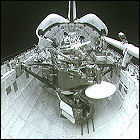 Space Shuttle Discovery lifts off on a five-day mission to deliver the Upper Atmosphere Research Satellite (UARS) into a low Earth orbit, where the satellite spends over a year studying the outer layers of Earth’s atmosphere. UARS also focuses on study of Earth’s ozone layer. Other experiments are carried out aboard the orbiter by Commander John Creighton, Pilot Kenneth Reightler, , and mission specialists Mark Brown, Charles Gemar and James Buchli.
Space Shuttle Discovery lifts off on a five-day mission to deliver the Upper Atmosphere Research Satellite (UARS) into a low Earth orbit, where the satellite spends over a year studying the outer layers of Earth’s atmosphere. UARS also focuses on study of Earth’s ozone layer. Other experiments are carried out aboard the orbiter by Commander John Creighton, Pilot Kenneth Reightler, , and mission specialists Mark Brown, Charles Gemar and James Buchli.
STS-43
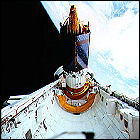 NASA launches Space Shuttle Atlantis on a satellite deployment and science mission lasting nearly nine days. The fourth TDRS (Tracking & Data Relay Satellite) is launched, and several experiments are performed on board, including materials processing experiments. Atlantis’ crew consists of Commander John Blaha, Pilot Michael Baker, and mission specialists Shannon Lucid, James Adamson and David Low.
NASA launches Space Shuttle Atlantis on a satellite deployment and science mission lasting nearly nine days. The fourth TDRS (Tracking & Data Relay Satellite) is launched, and several experiments are performed on board, including materials processing experiments. Atlantis’ crew consists of Commander John Blaha, Pilot Michael Baker, and mission specialists Shannon Lucid, James Adamson and David Low.
STS-40
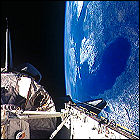 Space Shuttle Columbia lifts off on a nine-day mission with – for the first time in the shuttle program – a crew that’s nearly 50% female. Columbia carries the Spacelab module into orbit for a series of life sciences and biology experiments, the first flight devoted to such experiments since the Skylab era. Aboard Columbia for this flight are Commander Bryan O’Connor, Pilot Sidney Gutierrez, and mission specialists James Bagian, Tamara Jernigan, Rhea Seddon, Drew Gaffney and Millie Hughes-Fulford.
Space Shuttle Columbia lifts off on a nine-day mission with – for the first time in the shuttle program – a crew that’s nearly 50% female. Columbia carries the Spacelab module into orbit for a series of life sciences and biology experiments, the first flight devoted to such experiments since the Skylab era. Aboard Columbia for this flight are Commander Bryan O’Connor, Pilot Sidney Gutierrez, and mission specialists James Bagian, Tamara Jernigan, Rhea Seddon, Drew Gaffney and Millie Hughes-Fulford.
Soyuz TM-12: the first British astronaut
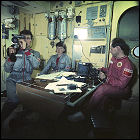 Helen Sharman becomes the first British national in space, flying aboard Soyuz TM-12 to the Soviet space station Mir. Making her flight in a seat bought and paid for by a consortium of British commercial interests, Sharman tags along with cosmonauts Anatoly Artsebarsky and Sergei Krikalev, and she spends just a week in orbit before returning with Soyuz TM-13 cosmonaut Toktar Aubakirov. Artsebarsky and Krikalev remain aboard Mir for what is initially planned to be a five-month stay, though a shake-up in the flight schedule forces mission planners to ask Krikalev to stay aboard Mir even after Artsebarsky returns to Earth, resulting in Krikalev remaining on Mir for 10 months, not returning home until 1992 – at which point the Soviet Union will have ceased to exist.
Helen Sharman becomes the first British national in space, flying aboard Soyuz TM-12 to the Soviet space station Mir. Making her flight in a seat bought and paid for by a consortium of British commercial interests, Sharman tags along with cosmonauts Anatoly Artsebarsky and Sergei Krikalev, and she spends just a week in orbit before returning with Soyuz TM-13 cosmonaut Toktar Aubakirov. Artsebarsky and Krikalev remain aboard Mir for what is initially planned to be a five-month stay, though a shake-up in the flight schedule forces mission planners to ask Krikalev to stay aboard Mir even after Artsebarsky returns to Earth, resulting in Krikalev remaining on Mir for 10 months, not returning home until 1992 – at which point the Soviet Union will have ceased to exist.
STS-39
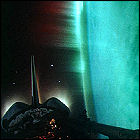 Space Shuttle Discovery lifts off on an eight-day mission to delivery both classified and unclassified Defense Department payloads into Earth orbit. Aboard the shuttle for this flight are Commander Michael Coats, Pilot Blaine Hammond, and mission specialists Guion Bluford, Gregory Harbaugh, Richard Hieb, Donald McMonagle and Charles Veach.
Space Shuttle Discovery lifts off on an eight-day mission to delivery both classified and unclassified Defense Department payloads into Earth orbit. Aboard the shuttle for this flight are Commander Michael Coats, Pilot Blaine Hammond, and mission specialists Guion Bluford, Gregory Harbaugh, Richard Hieb, Donald McMonagle and Charles Veach.
STS-37
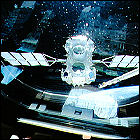 Space Shuttle Atlantis lifts off on a mission to deploy the orbiting Gamma Ray Observatory satellite. When the high-gain antenna fails to deploy on GRO, the first unplanned spacewalk since 1985 is conducted, with two of the astronauts manually releasing the antenna. Manning Atlantis for nearly six days are Commander Steven Nagel, Pilot Kenneth Cameron, and mission specialists Jerry Ross, Jay Apt and Linda Godwin.
Space Shuttle Atlantis lifts off on a mission to deploy the orbiting Gamma Ray Observatory satellite. When the high-gain antenna fails to deploy on GRO, the first unplanned spacewalk since 1985 is conducted, with two of the astronauts manually releasing the antenna. Manning Atlantis for nearly six days are Commander Steven Nagel, Pilot Kenneth Cameron, and mission specialists Jerry Ross, Jay Apt and Linda Godwin.
Space Station Fred
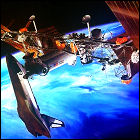 At the insistence of Congress, NASA submits a significant redesign of the long-overdue and over-budget Space Station Freedom for approval. Where previous design changes tried to retain a massive “dual keel” allowing for experiment modules and other activities that could be performed a safe distance away from the station’s habitation modules, the new Space Station Freedom clusters all of its modules together in one place and removes the dual keel structure permanently. Scoffing at the truncated new design, critics refer to the newly-submitted proposal as “Space Station Fred” instead of “Space Station Freedom”.
At the insistence of Congress, NASA submits a significant redesign of the long-overdue and over-budget Space Station Freedom for approval. Where previous design changes tried to retain a massive “dual keel” allowing for experiment modules and other activities that could be performed a safe distance away from the station’s habitation modules, the new Space Station Freedom clusters all of its modules together in one place and removes the dual keel structure permanently. Scoffing at the truncated new design, critics refer to the newly-submitted proposal as “Space Station Fred” instead of “Space Station Freedom”.
Salyut 7’s plunge to Earth
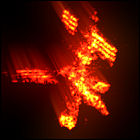 The last of the Salyut space stations from the heyday of the Soviet space program, Salyut 7 tumbles into the Earth’s atmosphere, its supply of fuel exhausted. (No cosmonauts have occupied Salyut 7 since 1986.) With the large Kosmos 1686 expansion still docked, most of Salyut 7 disintegrates in the atmosphere, though some debris is scattered over Argentina. Salyut 7 lasted nearly nine years in orbit.
The last of the Salyut space stations from the heyday of the Soviet space program, Salyut 7 tumbles into the Earth’s atmosphere, its supply of fuel exhausted. (No cosmonauts have occupied Salyut 7 since 1986.) With the large Kosmos 1686 expansion still docked, most of Salyut 7 disintegrates in the atmosphere, though some debris is scattered over Argentina. Salyut 7 lasted nearly nine years in orbit.
Soyuz TM-11: live from orbit
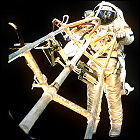 Soyuz TM-11 lifts off from the Baikonur Cosmodrome in the Soviet Union, bound for the space station Mir. Aboard the Soyuz is a crew of three: cosmonauts Viktor Afanasyev and Musa Manarov, with Tokyo Broadcasting System reporter Toyohiro Akiyama, who transmits live reports from Mir for the duration of his week in orbit. (Akiyama will return to Earth with the Soyuz TM-10 crew.) Akiyama is the first space traveler whose seat has been commercially bought and paid for, a flight which ignites the “space tourism” industry built around buying Soyuz seats. Afanasyev and Manarov remain in orbit for 175 days, returning to Earth with British space traveler Helen Sharman in May 1991.
Soyuz TM-11 lifts off from the Baikonur Cosmodrome in the Soviet Union, bound for the space station Mir. Aboard the Soyuz is a crew of three: cosmonauts Viktor Afanasyev and Musa Manarov, with Tokyo Broadcasting System reporter Toyohiro Akiyama, who transmits live reports from Mir for the duration of his week in orbit. (Akiyama will return to Earth with the Soyuz TM-10 crew.) Akiyama is the first space traveler whose seat has been commercially bought and paid for, a flight which ignites the “space tourism” industry built around buying Soyuz seats. Afanasyev and Manarov remain in orbit for 175 days, returning to Earth with British space traveler Helen Sharman in May 1991.
STS-35
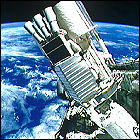 Space Shuttle Columbia lifts off for an eight-day mission to become a manned space telescope in Earth orbit, carrying the ASTRO-1 package designed to conduct X-ray and ultraviolet astronomy, mounted on an unmanned Spacelab pallet in the cargo bay. The mission has been delayed for months, most notably by hydrogen leaks detected long before the original May launch date. Manning Columbia for this flight are Commander Vance Brand, Pilot Guy Gardner, mission specialists Jeffrey Hoffman, John Lounge and Robert Parker, and payload specialists Samuel Durrance and Ronald Parise.
Space Shuttle Columbia lifts off for an eight-day mission to become a manned space telescope in Earth orbit, carrying the ASTRO-1 package designed to conduct X-ray and ultraviolet astronomy, mounted on an unmanned Spacelab pallet in the cargo bay. The mission has been delayed for months, most notably by hydrogen leaks detected long before the original May launch date. Manning Columbia for this flight are Commander Vance Brand, Pilot Guy Gardner, mission specialists Jeffrey Hoffman, John Lounge and Robert Parker, and payload specialists Samuel Durrance and Ronald Parise.
STS-38
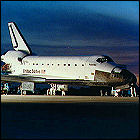 Space Shuttle Atlantis is launched on a mission involving a classified Defense Department payload, staying in Earth orbit for nearly five days. Atlantis’ crew on this flight consists of Commander Richard Covey, Pilot Frank Culbertson, and mission specialists Robert Springer, Carl Meade and Charles Gemar.
Space Shuttle Atlantis is launched on a mission involving a classified Defense Department payload, staying in Earth orbit for nearly five days. Atlantis’ crew on this flight consists of Commander Richard Covey, Pilot Frank Culbertson, and mission specialists Robert Springer, Carl Meade and Charles Gemar.
STS-41
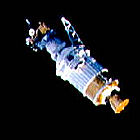 Space Shuttle Discovery lifts off to deliver another space probe whose launch has been delayed in recent years, the Ulysses mission. The remnant of a more elaborate (but ultimately scrapped) International Solar Polar mission, Ulysses is the first and only shuttle payload to use a two-stage booster to launch it from Earth orbit into a high, looping trajectory out of the plane of the ecliptic (roughly corresponding to the sun’s equator, around which the solar system’s planets orbit). Ulysses, built and managed by the European Space Agency, promises the first views of the sun’s polar regions. Discovery’s crew is Commander Richard N. Richards, Pilot Robert Cabana, and mission specialists William Shepherd, Bruce Melnick and Thomas Akers. Discovery lands at Edwards Air Force Base after four days in orbit.
Space Shuttle Discovery lifts off to deliver another space probe whose launch has been delayed in recent years, the Ulysses mission. The remnant of a more elaborate (but ultimately scrapped) International Solar Polar mission, Ulysses is the first and only shuttle payload to use a two-stage booster to launch it from Earth orbit into a high, looping trajectory out of the plane of the ecliptic (roughly corresponding to the sun’s equator, around which the solar system’s planets orbit). Ulysses, built and managed by the European Space Agency, promises the first views of the sun’s polar regions. Discovery’s crew is Commander Richard N. Richards, Pilot Robert Cabana, and mission specialists William Shepherd, Bruce Melnick and Thomas Akers. Discovery lands at Edwards Air Force Base after four days in orbit.
Soyuz TM-10
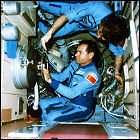 The Soviet Union launches Soyuz TM-10, carrying cosmonauts Gennadi Manakov and Gennady Strekalov to space station Mir for a long-duration stay in orbit. After a 130-day stay aboard Mir, the TM-10 crew returns, bringing with them Japanese TV reporter Toyohiro Akiyama, who would arrive aboard Mir via Soyuz TM-11 in December. Strekalov will return to serve another tour aboard Mir in the 1990s, becoming the first Russian cosmonaut to arrive in a Soyuz and return home in an American space shuttle.
The Soviet Union launches Soyuz TM-10, carrying cosmonauts Gennadi Manakov and Gennady Strekalov to space station Mir for a long-duration stay in orbit. After a 130-day stay aboard Mir, the TM-10 crew returns, bringing with them Japanese TV reporter Toyohiro Akiyama, who would arrive aboard Mir via Soyuz TM-11 in December. Strekalov will return to serve another tour aboard Mir in the 1990s, becoming the first Russian cosmonaut to arrive in a Soyuz and return home in an American space shuttle.
Kristall module docks at Mir
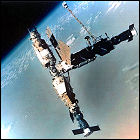 The Soviet Union launches the Kristall module, whose pre-programmed systems bring it to the Mir space station for an automated docking. With facilities for material science experiments, additional gyroscopic stabilizers to keep Mir properly oriented, and other equipment, Kristall also features an extended docking port intended to allow the Soviet-made Buran shuttle to dock at Mir. In time, that docking port will allow a space shuttle to berth at Mir… but not the one its designers anticipate.
The Soviet Union launches the Kristall module, whose pre-programmed systems bring it to the Mir space station for an automated docking. With facilities for material science experiments, additional gyroscopic stabilizers to keep Mir properly oriented, and other equipment, Kristall also features an extended docking port intended to allow the Soviet-made Buran shuttle to dock at Mir. In time, that docking port will allow a space shuttle to berth at Mir… but not the one its designers anticipate.
This is the last expansion made to Mir prior to the collapse of the Soviet Union, and the last new module to arrive for five years.
STS-31: launching Hubble
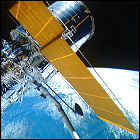 In the planning stages since the 1970s, and delayed by the post-Challenger-disaster downtime for the shuttle program, the Hubble Space Telescope is finally lifted into orbit aboard Space Shuttle Discovery. Hubble is just one of the scientific payloads for the five-day flight, with other experiments being conducted in the crew cabin and the cargo bay. Discovery’s crew for this flight is Commander Loren Shriver, Pilot Charles Bolden, and mission specialists Steven Hawley, Bruce McCandless and Kathryn Sullivan.
In the planning stages since the 1970s, and delayed by the post-Challenger-disaster downtime for the shuttle program, the Hubble Space Telescope is finally lifted into orbit aboard Space Shuttle Discovery. Hubble is just one of the scientific payloads for the five-day flight, with other experiments being conducted in the crew cabin and the cargo bay. Discovery’s crew for this flight is Commander Loren Shriver, Pilot Charles Bolden, and mission specialists Steven Hawley, Bruce McCandless and Kathryn Sullivan.
STS-36
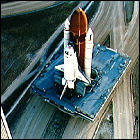 Space Shuttle Atlantis lifts off on a four-day Department of Defense mission, the specifics of which remain classified. The crew consists of Commander John Creighton, Pilot John Casper, and mission specialists Richard Mullane, David Hilmers and Pierre Thuot.
Space Shuttle Atlantis lifts off on a four-day Department of Defense mission, the specifics of which remain classified. The crew consists of Commander John Creighton, Pilot John Casper, and mission specialists Richard Mullane, David Hilmers and Pierre Thuot.
Soyuz TM-9 / Mir Expedition EO-6
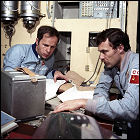 Cosmonauts Anatoly Solovyev
Cosmonauts Anatoly Solovyev
and Aleksandr Balandin lift off from the Soviet Union aboard Soyuz TM-9, on their way to a stay aboard the Mir space station. Upon arriving at the station, an inspection of their spacecraft reveals that some of the Soyuz’ thermal blankets detached themselves during launch, though ground controllers decide against such drastic measures as cutting the mission short or launching Soyuz TM-10 early as a rescue mission. Solovyev and Balandin remain aboard Mir for 179 days, greeting the station’s next crew in August and returning to Earth without incident.
STS-32
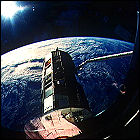 Space Shuttle Columbia lifts off on a ten-day mission to deploy the LEASAT 5 communications satellite and retrieve the Long Duration Exposure Facility satellite that had been placed in orbit in 1984 by Challenger. (LDEF retrieval, delayed from 1985, had been put off by several additional years by the Challenger accident and its aftermath.) Aboard Columbia in this flight are Commander Daniel Brandenstein, Pilot James Wetherbee, and mission specialists Bonnie Dunbar, G. David Low, and Marsha Ivins.
Space Shuttle Columbia lifts off on a ten-day mission to deploy the LEASAT 5 communications satellite and retrieve the Long Duration Exposure Facility satellite that had been placed in orbit in 1984 by Challenger. (LDEF retrieval, delayed from 1985, had been put off by several additional years by the Challenger accident and its aftermath.) Aboard Columbia in this flight are Commander Daniel Brandenstein, Pilot James Wetherbee, and mission specialists Bonnie Dunbar, G. David Low, and Marsha Ivins.
STS-33
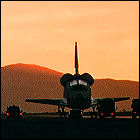 Space Shuttle Discovery lifts off on 1989’s fifth and final shuttle launch, delivering a classified Defense Department payload into orbit on a five-day mission. Aboard Discovery are Commander Frederick Gregory, Pilot John Blaha, and mission specialists Story Musgrave, Manley Carter, and Kathryn Thornton.
Space Shuttle Discovery lifts off on 1989’s fifth and final shuttle launch, delivering a classified Defense Department payload into orbit on a five-day mission. Aboard Discovery are Commander Frederick Gregory, Pilot John Blaha, and mission specialists Story Musgrave, Manley Carter, and Kathryn Thornton.
Kvant stop now: Mir grows again
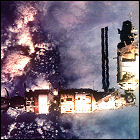 The Soviet Union launches the third Mir space station module, Kvant-2, to rendezvous and dock with Mir under automated control. With an airlock to make spacewalks easier, and additional living space and life support, Kvant also includes bathing facilities, water storage and reclamation systems (including a system to collect, detoxify and recycle human urine), and additional scientific equipment.
The Soviet Union launches the third Mir space station module, Kvant-2, to rendezvous and dock with Mir under automated control. With an airlock to make spacewalks easier, and additional living space and life support, Kvant also includes bathing facilities, water storage and reclamation systems (including a system to collect, detoxify and recycle human urine), and additional scientific equipment.
STS-34
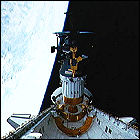 Space Shuttle Atlantis lifts off on a mission lasting nearly five days, whose primary goal is to lift the interplanetary probe Galileo into orbit. Originally intended for launch in late 1982, Galileo is bound for Jupiter by way of a long, looping trajectory that sends it to Venus and back to Earth multiple times, picking up speed via gravitational assist with each visit. Galileo won’t actually reach Jupiter itself until December 1995. Aboard Atlantis for this flight are Commander Donald Williams, Pilot Michael McCulley, and mission specialists Franklin Chang-Diaz, Shannon Lucid, and Ellen S. Baker.
Space Shuttle Atlantis lifts off on a mission lasting nearly five days, whose primary goal is to lift the interplanetary probe Galileo into orbit. Originally intended for launch in late 1982, Galileo is bound for Jupiter by way of a long, looping trajectory that sends it to Venus and back to Earth multiple times, picking up speed via gravitational assist with each visit. Galileo won’t actually reach Jupiter itself until December 1995. Aboard Atlantis for this flight are Commander Donald Williams, Pilot Michael McCulley, and mission specialists Franklin Chang-Diaz, Shannon Lucid, and Ellen S. Baker.
The People vs. Galileo?
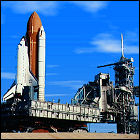 A lawsuit, filed by environmental activists worried about the release of plutonium from the Galileo Jupiter probe’s radioisotope thermoelectric generators in the event of a Challenger-like disaster during launch, is dismissed by a federal judge; the President of the United States has also given permission for the launch to proceed (a requirement anytime a nuclear-fueled spacecraft is in the works). The suit, filed earlier in the year, sought an injunction to prevent Galileo from being launched. Times have changed since the last RTG-powered flight (the Voyager missions of the 1970s), and activists are concerned about a Chernobyl-style radioactive disaster, although the plutonium 238 at the heart of Galileo’s power supply (and that of other interplanetary probes that have used it) is non-weapons-grade and non-fissible. Galileo is slated to be launched in a week aboard the space shuttle Atlantis.
A lawsuit, filed by environmental activists worried about the release of plutonium from the Galileo Jupiter probe’s radioisotope thermoelectric generators in the event of a Challenger-like disaster during launch, is dismissed by a federal judge; the President of the United States has also given permission for the launch to proceed (a requirement anytime a nuclear-fueled spacecraft is in the works). The suit, filed earlier in the year, sought an injunction to prevent Galileo from being launched. Times have changed since the last RTG-powered flight (the Voyager missions of the 1970s), and activists are concerned about a Chernobyl-style radioactive disaster, although the plutonium 238 at the heart of Galileo’s power supply (and that of other interplanetary probes that have used it) is non-weapons-grade and non-fissible. Galileo is slated to be launched in a week aboard the space shuttle Atlantis.
Soyuz TM-8 / Mir Expedition EO-5
 Cosmonauts Alexander Viktorenko and Aleksandr Serebrov lift off aboard the Soviet spacecraft Soyuz TM-8, bound for the presently unoccupied space station Mir (which had been left without a crew since April 1989). At a distance of only 4 meters to Mir’s docking hatch, Soyuz TM-8 suffers a breakdown of its automated docking system, and Viktorenko has no choice but to back the Soyuz away and carefully dock under manual control. The two-man crew remains aboard Mir for 166 days, returning to Earth in February 1990.
Cosmonauts Alexander Viktorenko and Aleksandr Serebrov lift off aboard the Soviet spacecraft Soyuz TM-8, bound for the presently unoccupied space station Mir (which had been left without a crew since April 1989). At a distance of only 4 meters to Mir’s docking hatch, Soyuz TM-8 suffers a breakdown of its automated docking system, and Viktorenko has no choice but to back the Soyuz away and carefully dock under manual control. The two-man crew remains aboard Mir for 166 days, returning to Earth in February 1990.
STS-28
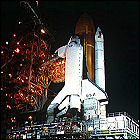 Lifting off on its first spaceflight since January 1986, Space Shuttle Columbia heads into orbit on a five-day classified Department of Defense mission. Columbia’s crew for this flight consists of Commander Brewster Shaw, Pilot Richard Richards, and mission specialists James Adamson, David Leestma and Mark Brown.
Lifting off on its first spaceflight since January 1986, Space Shuttle Columbia heads into orbit on a five-day classified Department of Defense mission. Columbia’s crew for this flight consists of Commander Brewster Shaw, Pilot Richard Richards, and mission specialists James Adamson, David Leestma and Mark Brown.
HL-20: the mini-shuttle that almost was
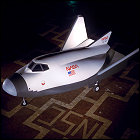 NASA begins intensive work, including the construction of a full-sized test article, on the HL-20, a vehicle being considered for “assured access” to the space station NASA plans to build in the 1990s. HL-20 is based upon the scale-model unmanned BOR4 vehicle test-launched four times by the Soviet Union, and testing will get as far as NASA conducting simulations to determine seating and cargo placement. Despite the relatively recent Challenger disaster, the HL-20 project is quietly dropped in the early 1990s since no urgent need is seen on a widespread basis throughout NASA to phase out or replace the Space Shuttle. The design will be revived in the 21st century by Sierra Nevada Corproation as the proposed Dream Chaser vehicle.
NASA begins intensive work, including the construction of a full-sized test article, on the HL-20, a vehicle being considered for “assured access” to the space station NASA plans to build in the 1990s. HL-20 is based upon the scale-model unmanned BOR4 vehicle test-launched four times by the Soviet Union, and testing will get as far as NASA conducting simulations to determine seating and cargo placement. Despite the relatively recent Challenger disaster, the HL-20 project is quietly dropped in the early 1990s since no urgent need is seen on a widespread basis throughout NASA to phase out or replace the Space Shuttle. The design will be revived in the 21st century by Sierra Nevada Corproation as the proposed Dream Chaser vehicle.
STS-30
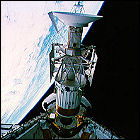 Space Shuttle Atlantis lifts off on a four-day mission to launch the long-delayed interplanetary probe Magellan, which is sent to Venus via an Interial Upper Stage booster module. For the first time, one of a shuttle’s five onboard computers fails and is replaced in an in-orbit repair procedure. Aboard Atlantis for this flight are Commander David Walker, Pilot Ronald Grabe, and mission specialists Norm Thagard, Mary Cleave and Mark Lee. The launch of Magellan, a mission originally conceived in 1972, marks the beginning of the first American interplanetary mission since 1977.
Space Shuttle Atlantis lifts off on a four-day mission to launch the long-delayed interplanetary probe Magellan, which is sent to Venus via an Interial Upper Stage booster module. For the first time, one of a shuttle’s five onboard computers fails and is replaced in an in-orbit repair procedure. Aboard Atlantis for this flight are Commander David Walker, Pilot Ronald Grabe, and mission specialists Norm Thagard, Mary Cleave and Mark Lee. The launch of Magellan, a mission originally conceived in 1972, marks the beginning of the first American interplanetary mission since 1977.
STS-29
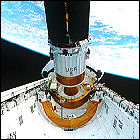 Space Shuttle Discovery lifts off on a nearly-five-day mission to take NASA’s third TDRS (Tracking & Data Relay Satellite) into orbit, among other smaller experiment packages, including IMAX filming. Aboard Discovery for the first shuttle flight of 1989 are Commander Michael Coats, Pilot John Blaha, and mission specialists James Bagian, James Buchli, and Robert Springer.
Space Shuttle Discovery lifts off on a nearly-five-day mission to take NASA’s third TDRS (Tracking & Data Relay Satellite) into orbit, among other smaller experiment packages, including IMAX filming. Aboard Discovery for the first shuttle flight of 1989 are Commander Michael Coats, Pilot John Blaha, and mission specialists James Bagian, James Buchli, and Robert Springer.
Damaged goods: Atlantis returns
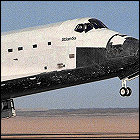 Space Shuttle Atlantis returns to Earth from a classified four-day mission to deploy a payload for the Department of Defense, and on only the second flight since the Challenger disaster, most of Atlantis’ crew are surprised to return to Earth at all. During the mission, they note that Atlantis is missing numerous heat shield tiles along the vehicle’s right side and its wing – a post-landing damage survey counts over 700 missing tiles, making Atlantis the most-damaged orbiter to return safely from space. The damage had been pointed out to ground controllers by the crew, but when NASA asks permission from the Defense Department to allow the crew to send a live TV signal to Earth so engineers can survey the damage in orbit, that permission is refused. A slow-scan encrypted video system is used instead, and its low resolution doesn’t reveal the extent of the damage. The damage is believed to have been caused by insulation vibrating loose from the solid rocket booster and the external fuel tank and striking the shuttle during launch, an almost identical cause of damage that proves catastrophic to another shuttle 15 years later.
Space Shuttle Atlantis returns to Earth from a classified four-day mission to deploy a payload for the Department of Defense, and on only the second flight since the Challenger disaster, most of Atlantis’ crew are surprised to return to Earth at all. During the mission, they note that Atlantis is missing numerous heat shield tiles along the vehicle’s right side and its wing – a post-landing damage survey counts over 700 missing tiles, making Atlantis the most-damaged orbiter to return safely from space. The damage had been pointed out to ground controllers by the crew, but when NASA asks permission from the Defense Department to allow the crew to send a live TV signal to Earth so engineers can survey the damage in orbit, that permission is refused. A slow-scan encrypted video system is used instead, and its low resolution doesn’t reveal the extent of the damage. The damage is believed to have been caused by insulation vibrating loose from the solid rocket booster and the external fuel tank and striking the shuttle during launch, an almost identical cause of damage that proves catastrophic to another shuttle 15 years later.
STS-27
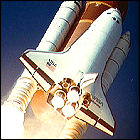 Space Shuttle Atlantis lifts off on the 27th shuttle flight, a four-day mission to launch a classified Defense Department payload. The crew aboard Atlantis for this flight consists of Commander Robert Gibson, Pilot Guy Gardner, and mission specialists Richard Mullane, Jerry Ross, and William Shepherd. All other information about this flight, including launch weight and even Atlantis’ orbital altitude, remain classified to this day.
Space Shuttle Atlantis lifts off on the 27th shuttle flight, a four-day mission to launch a classified Defense Department payload. The crew aboard Atlantis for this flight consists of Commander Robert Gibson, Pilot Guy Gardner, and mission specialists Richard Mullane, Jerry Ross, and William Shepherd. All other information about this flight, including launch weight and even Atlantis’ orbital altitude, remain classified to this day.
Soyuz TM-7
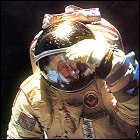 The Soviet Union launches Soyuz TM-7 to space station Mir, ferrying cosmonauts Alexander Volkov and Sergei Krikalev, and French spationaut Jean-Loup Chrétien to the station. Volkov and Krikalev will remain aboard Mir for 151 days, while Chrétien will remain for a shorter 24-day mission. Chrétien had visited the Salyut 7 space station on his previous spaceflight; his next flight, in 1997, will visit Mir again, this time by way of Space Shuttle Atlantis. Unusually, the return of this Mir crew will leave the station unoccupied for almost half a year.
The Soviet Union launches Soyuz TM-7 to space station Mir, ferrying cosmonauts Alexander Volkov and Sergei Krikalev, and French spationaut Jean-Loup Chrétien to the station. Volkov and Krikalev will remain aboard Mir for 151 days, while Chrétien will remain for a shorter 24-day mission. Chrétien had visited the Salyut 7 space station on his previous spaceflight; his next flight, in 1997, will visit Mir again, this time by way of Space Shuttle Atlantis. Unusually, the return of this Mir crew will leave the station unoccupied for almost half a year.